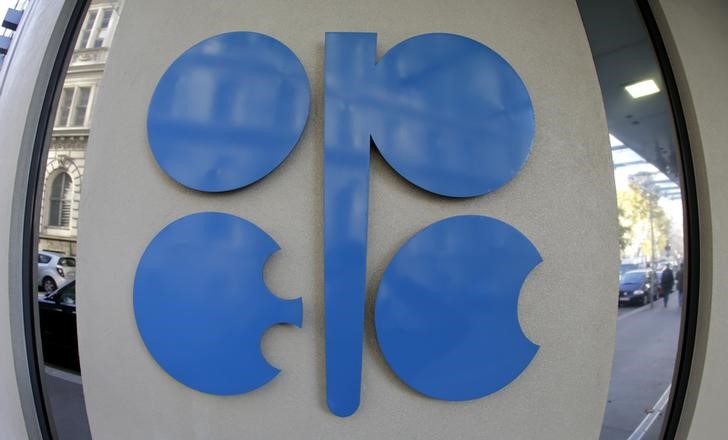(Bloomberg) -- OPEC is enduring one of the most head-spinning years in its history, swerving from cutting oil production to boosting it as quickly as possible. It may need to reverse course again.
Saudi Arabia and other producers gathering in Abu Dhabi this weekend face a worrying prospect: Even though U.S. sanctions on Iran are removing significant amounts of crude from world markets, a fresh surge of American shale oil threatens to unleash a new surplus in 2019.
Crude prices already reflect these concerns. Brent for January delivery has retreated about 17 percent from a four-year high reached in early October. The Organization of Petroleum Exporting Countries and its allies are showing they’re worried, signaling last month that they might need to dial back near-record output levels.
“The message from OPEC looks like: fasten the seat belts,” said Bob McNally, president of Rapidan Energy Advisors LLC, a consultant in Washington. The cartel looks sets to “put pedal to the metal to boost production, and then immediately slam the breaks pretty hard and talk about cutting supply."
If group-leader Saudi Arabia does ultimately decide fresh cutbacks are necessary, it will confront a number of challenges. It will need to once again secure the support of rival-turned-partner Russia, which has less need for high oil prices. There’s also the risk of antagonizing the kingdom’s key geopolitical ally, U.S. President Donald Trump.
Powerful Forces
All this is a far cry from the usual OPEC mantra of preserving stability and careful market stewardship. Yet it does reflect the level of uncertainty in a market experiencing huge shifts in supply and demand.
Earlier in the summer, Brent surged above $86 a barrel as the risk of production shortfalls from sanctions on Iran and Venezuela’s economic collapse rattled the market. Losses from those two OPEC members threatened the biggest supply disruption since the start of the decade.
Yet big things are happening on the other side of the supply equation too, meaning the risk of scarcity may not last. OPEC has been in “produce as much as you can mode” to reassure consumers, Saudi Energy Minister Khalid Al-Falih said in Riyadh last month. The kingdom has lifted output close to record levels, while Libya is pumping the most in five years.
Then there’s the small matter of U.S. production growing at the fastest rate in a century, just as fuel demand is at risk from the slowdown in emerging economies and the U.S.-China trade war.
Well Supplied
Right now, global markets are now “well supplied,” in the assessment of the International Energy Agency, which advises consuming nations. OPEC’s own projections show that next year the world will need about 1 million barrels a day less than the 31.8 million its 15 members pumped in September.
“They will absolutely want to at some point next year try to arrange a reduction in production,” said Ed Morse, head of commodities at Citigroup Inc (NYSE:C). “Everything points to a fairly weak balance: the world economy is decelerating, the China trade tensions are having a visible impact on demand.”
The meeting this weekend of the Joint Ministerial Monitoring Committee, a six-nation body representing the broader 25-country coalition, is intended as just an interim review before all ministers discuss policy next month in Vienna. Still, it could give a significant indication of what’s to come.
"When OPEC looks at the challenge with the shale story in 2019, what does it need to do -- does it have to start signaling now?” said Helima Croft, chief commodities strategist at RBC Capital Markets LLC. “At this JMMC, do we get any clues that OPEC needs to get back into active market management."
Big Decision
There’s a lot to consider before the December meeting. U.S. sanctions could end up squeezing Iranian output so much that other producers won’t need to cut. Although Washington granted some of Iran’s customers temporary waivers that let them keep buying, the Trump administration has said repeatedly it intends to entirely choke off the country’s energy revenues.
Shale has plenty of potential to surprise. The U.S. is already poised to satisfy most of the increase in global oil demand next year, the IEA forecasts. In August, a surprise surge in output meant the country briefly overtook Russia as the world’s biggest crude producer, with output of 11.3 million barrels a day. The Energy Information Administration just increased its 2019 production forecast by 300,000 barrels a day to 12.06 million.
Then there are political considerations. The Saudis may struggle to persuade the rest of OPEC to return to cutting production. Some members, like Iraq, are pressing on with new projects. Others may have grown weary of having their production policy steered by the kingdom.
Russia, the most important non-OPEC partner in the coalition, has ramped up output to a post-Soviet record and President Vladimir Putin has said he’s comfortable with prices in a $65 to $75 a range, giving some downside from the current level of $71 in London.
If another cuts agreement can be secured, it could prompt renewed attacks from President Trump or encourage U.S. lawmakers to advance anti-cartel legislation known as NOPEC.
“There’s a lot at stake for them if they antagonize the wrong sets of people in consuming countries,” said Citigroup’s Morse.
Here’s a rundown of how these competing forces could shape the decision next month:
